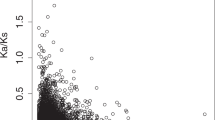Abstract
Mammalian evolution is believed to be male driven because the greater number of germ cell divisions per generation in males increases the opportunity for errors in DNA replication. Since the Y Chromosome (Chr) replicates exclusively in males, its genes should also evolve faster than X or autosomal genes. In addition, estimating the overall male-to-female mutation ratio (αm) is of great importance as a large αm implies that replication-independent mutagenic events play a relatively small role in evolution. A small αm suggests that the impact of these factors may, in fact, be significant. In order to address this problem, we have analyzed the rates of evolution in the homologous X-Y common SMCX/SMCY genes from three different species—mouse, human, and horse. The SMC genes were chosen because the X and Y copies are highly homologous, well conserved in evolution, and in all probability functionally interchangeable. Sequence comparisons and analysis of synonymous substitutions in approximately 1kb of the 5′ coding region of the SMC genes reveal that the Y-linked copies are evolving approximately 1.8 times faster than their X homologs. The male-to-female mutation ratio αm was estimated to be 3. These data support the hypothesis that mammalian evolution is male driven. However, the ratio value is far smaller than suggested in earlier works, implying significance of replication-independent mutagenic events in evolution.
Similar content being viewed by others
References
Agulnik AI, Mitchell M, Lerner JL, Woods DR, Bishop CE(1994a). A mouse Y chromosome gene encoded by a region essential for spermatogenesis and expression of male-specific minor histocompatibility antigens. Hum Mol Genet 3, 873–878
Agulnik AI, Mitchell M, Mattei M-G, Borsani G, Avner PA, Lerner JL, Bishop CE (1994b). A novel X gene with a widely transcribed Y-linked homologue escapes X-inactivation in mouse and human. Hum Mol Genet 3, 879–884
Chang BH-J, Hewett-Emmett D, Li W-H (1996). Male-to-female ratios of mutation rate in higher primates estimated from intron sequences. Zool Studies, in press
Chang BH-J, Li W-H (1995). Estimating the intensity of male-driven evolution in rodents by using X-linked and Y-linked Ube 1 genes and pseudogenes. J Mol Evol 40, 70–77
Chang BH-J, Shimmin LC, Shyue SK, Hewett-Emmett D, Li W-H (1994). Weak male-driven molecular evolution in rodents. Proc Natl Acad Sci USA 91, 827–831
Felsenstein J (1991). PHYLIP (Phylogeny Inference Package), version 3.4. Distributed by the author, Univ. Washington, Seattle
Graves JAM (1995). The origin and function of the mammalian Y chromosome and Y-borne genes—an evolving understanding. BioEssays 17, 311–321
Hayashida H, Kuma K-i, Miyata T (1992). Interchromosomal gene conversion as a possible mechanism for explaining divergence patterns of ZFY-related genes. J Mol Evol 35, 181–183
Lanfear J, Holland PWH(1991). The molecular evolution of ZFY-related genes in birds and mammals. J Mol Evol 32, 310–315
Li W-H (1993). Unbiased estimation of the rates of synonymous and nonsynonymous substitution. J Mol Evol 36, 96–99
Maddison WP, Maddison DR (1992). MacClade: Analysis of the Phylogeny and Character Evolution. (Sinauer, Sunderland, MA)
Miyata T, Hayashida H, Kuma K, Mitsuyasu K, Yasunaga T(1987). Male-driven molecular evolution: a model and nucleotide sequence analysis. Cold Spring Harbor Symp Quant Biol 52, 863–867
Palmer MS, Berta P, Sinclair AH, Pym B, Goodfellow PN (1990). Proc Natl Acad Sci USA 87, 1681–1685
Pamilo P, Bianchi NO(1993). Evolution of the Zfx and Zfy genes. Rates and interdependence between the genes. Mol Biol Evol 10, 271–281
Scott DM, Ehrmann IE, Ellis PS, Simpson E, Agulnik AI, Bishop CE, Mitchell MJ (1995). A male-specific transplantation antigen, H-Y is encoded by Smcy, a putative transcription factor gene on the mouse Y chromosome. Nature 376, 695–698
Schneider-Gadicke A, Beer-Romero P, Brown LG, Nussbaum R, Page DC (1989). ZFX has a gene structure similar to ZFY, the putative human sex determinant, and escapes X inactivation. Cell 57, 1247–1258
Shimmin LC, Chang BH-J, Hewett-Emmett D, Li W-H (1993a). Potential problems in estimating the male-to-female mutation rate ratio from DNA sequence data. J Mol Evol 37, 160–166
Shimmin LC, Chang BH-J, Li W-H (1993b). Male-driven evolution of DNA sequences. Nature 362, 745–747
Shimmin LC, Chang BHJ, Li W-H (1994). Contrasting rates of nucleotide substitution in the X-linked and Y-linked zinc finger genes. J Mol Evol 39, 569–578
Sneath PA, Sokal RR(1983). Numerical taxonomy. (W.H. Freeman and Co., San Francisco)
Tucker PK, Lundrigan BL (1993). Rapid evolution of the sex determining locus in Old World mice and rats. Nature 364, 715–717
Wang W, Meadows LR, den Haan JMM, Sherman NE, Chen Y, Blokland E, Shabanovitz J, Agulnik AI, Bishop CE, Hunt DF, Goulmy E, Engelhard VH (1995). Human H-Y: A male specific histocompatibility antigen derived from the SMCY protein. Science 269, 1588–1590
Whitfield S, Lovell-Badge R, Goodfellow PN (1993). Rapid sequence evolution of the mammalian sex-determining gene SRY. Nature 364, 713–715
Wolfe K, Sharp PM (1993) Mammalian gene evolution nucleotide sequence divergence between mouse and rat. J Mol Evol 37, 441–456.
Wu J, Ellison J, Salido ES, Yen PH, Mohandas TK, Shapiro LJ (1994a). Isolation and characterization of XE169, a novel human gene that escapes X-inactivation. Hum Mol Genet 3, 153–160
Wu J, Salido ES, Yen PH, Mohandas TK, Heng HHQ, Tsui L-C, Park J, Chapman V, Shapiro LJ(1994b). The murine Xel69 gene escapes X-inactivation like its human homologue. Nature Genet 7, 491–496
Author information
Authors and Affiliations
Additional information
The nucleotide sequence data reported in this paper have been submitted to GenBank and have been assigned accession numbers U52363, U52364, U52365.
Rights and permissions
About this article
Cite this article
Agulnik, A.I., Bishop, C.E., Lerner, J.L. et al. Analysis of mutation rates in the SMCY/SMCX genes shows that mammalian evolution is male driven. Mammalian Genome 8, 134–138 (1997). https://doi.org/10.1007/s003359900372
Received:
Accepted:
Issue Date:
DOI: https://doi.org/10.1007/s003359900372




